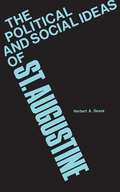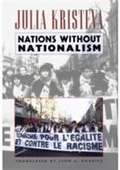- Table View
- List View
The Political and Social Ideas of St. Augustine
by Herbert A. DeaneHerbert A. Deane discusses St. Augustine's views on humankind, society, and the state, in terms of Augustine's theological, political, and social thought. Deane writes in his Preface that Augustine did not have a systematic philosophy. Because of this, the author's writes that his second aim of his book is to organize his ideas into the above categories. Deane, not only elucidates Augustine's thought clearly, he also substantiates his elucidation with massive quotations from Augustine's writings and from the writings of other philosophers, theologians, and political and social analysts and critics. The following quotations are taken from the back cover of the book: In describing Augustine, the author captures the essence of the man in these words: "Genius he had in full measure . . . he is the master of the phrase or the sentence that embodies a penetrating insight, a flash of lightning that illuminates the entire sky; he is the rhetorician, the epi-grammist, the polemicist, but not the patient, logical systematic philosopher." "Professor Deane has been remarkably successful in keeping different facets of Augustine's multi-dimensional thought in view . . . [he] significantly contributes both to historical understanding of Augustine's political thinking and to appreciation of its permanent relevance to the moral dilemmas of politics."
Nations Without Nationalism (European Perspectives)
by Richard Wolin Julia Kristeva Lawrence D. Kritzman Leon S. Roudiez<p>Underlying Julia Kristeva's latest work is the idea that otherness - whether it be ethnic, religious, social, or political - needs to be understood and accepted in order to guarantee social harmony. Nations Without Nationalism is an impassioned plea for tolerance and for commonality, aimed at a world brimming over with racism and xenophobia. <p>Responding to the rise of neo-Nazi groups in Germany and Eastern Europe and the continued popularity of the National Front in France, Kristeva turns to the origins of the nation-state to illustrate the problematic nature of nationalism and its complex configurations in subsequent centuries. <p>For Kristeva, the key to commonality can be found in Montesquieu's esprit general - his notion of the social body as a guaranteed hierarchy of private rights. <p>Nations Without Nationalism also contains Kristeva's thoughts on Harlem Desir, the founder of the antiracist organization SOS Racisme; the links between psychoanalysis and nationalism; the historical nature of French national identity; the relationship between esprit general and Volksgeist; Charles de Gaulle's complex ideas involving the "nation" and his dream of a unified Europe. <p>In the tradition of Strangers to Ourselves, her most recent nonfiction work, Nations Without Nationalism reflects a passionate commitment to enlightenment and social justice. As ethnic strife persists in Europe and the United States, Kristeva's humanistic message carries with it a special resonance and urgency.</p>
Journal Of My Life
by Robert Darnton Daniel Roche Jacques-Louis MénétraAn eighteenth-century Frenchman describes life in Paris, the events of the French Revolution, and his own fondness for pranks and jokes.
Nixon's Good Deed: Welfare Reform
by Vincent J. Burke Vee BurkeBut somewhere between conception and birth the Family Assistance Plan foundered. Most participants in the development and legislative process surrounding the Family Assistance Plan had differing ideas of what it could and could not accomplish. To some it was a harsh workfare program; to others a give-away guaranteed income program.
أسرار العربية
by أبو البركات الأنبارىيدور حول العلة النحوية، فهو لا يترك حكماً من الأحكام دون تعليل، بل يجعل لكل حكم علة ولكل ظاهرة سبباً ويتميز هذا الكتاب من أنه وضع لكل طريقة سؤال وجواب، وأنه يذكر الحكم مقروناً بأسبابه والظاهرة مشفوعة بعلتها، وأنه يتسم بكثرة الفوائد
إصلاح غلط المحدثين
by حمد بن محمد بن إبراهيم الخطابي البستيكتاب الإمام الخطابي "إصلاح غلط المحدثين" هو كتاب فريد من نوعه حيث يحث فيه المصنف بما يقع من أخطاء على ألسنة المحدثين والرواة حال تلاوتهم لأحاديث رسول الله مما قد يغير المعنى ويوضح خلاف المقصود فقصد فيه التنبيه لذلك لكي لا يؤول الحديث بغير ما أراده النبي
إعراب لامية الشنفرى
by أبو البقاء محب الدين عبدالله بن أبي عبدالله الحسين بن أبي البقاء عبدالله بن الحسين العكبرييناقش ابن هشام في كتابه "اعتراض الشرط على الشرط" بعض المسائل اللغوية الهامة المتعلقة بمسألة اعتراض الشرط على الشرط
الإتباع والمزاوجة
by أحمد بن فارس أبو الحسين الرازيرتب فيه ابن فارس كل ما عثر عليه من بابي الإتباع والمزاوجة. معتمداً في ترتيبه على الحرف الأخير من التابع والمتبوع واجتهد فيه أن يستخرج معنى للّفظ التابع
الإتباع للسيوطي
by أبو الفضل عبد الرحمن جلال الدين السيوطيكتاب "الاتباع" لأبو الفضل عبد الرحمن جلال الدين السيوطي هو احد كتب علوم اللغة
الاختيارين للأخفش
by الأخفشجمع الأخفش في كتابه "الأختيارين" بين المفضليات والأصمعيات وعلق عليها شرحاً يفسر بعض الغريب، ويوضح بعض المعاني البعيدة
التعريفات
by علي بن محمد بن علي الجرجانيمعجم يتضمن تحديد معاني المصطلحات المستخدمة في الفنون والعلوم حتى عصره، وهذا المعجم من أوائل المعاجم الاصطلاحية في التراث العربي، وقد حدد فيه الجرجاني معاني المصطلحات تبعا لمستخدميها وتبعا للعلوم والفنون التي تستخدم فيها، وجعل تلك المصطلحات مرتبة ترتيبا أبجديا مستفيدا في ذلك من المعاجم اللغوية حتى يسهل التعامل معه لكافة طالبيه، وهذا المعجم من المعاجم الهامة التي لا نستطيع الاستغناء عنها إلى الآن، وقد أشاد به كافة المستشرقين لأهميته الدلالية والتاريخية .
الراموز على الصحاح
by محمد بن السيد حسنكتاب "الراموز علي الصحاح" لمحمد بن السيد حسن هو احد كتب الدراسات المعجمية و علوم اللغة العربية
العدد فى اللغة
by علي بن إسماعيل بن سيده النحوي اللغويكتاب "العدد في اللغة" لعلي بن إسماعيل النحوي احد كتب علوم اللغة العربية و يتحدث فيه عن الأرقام و الاعداد و قواعدها في اللغة العربية
الكنز اللغوي
by ابن السكيت الاهوازيالكنز اللغوي في اللسن العربي نقلا عن نسخ قديمة سعى في نشره وتعليق حواشيه الدكتور اوغست هفنر معلم اللغات السامية في كلية فينا
اللامات
by عبد الرحمن الزجاجي، أبو القاسمهذا كتاب مختصر في ذكر اللامات ومواقعها في كلام العرب وكتاب الله عز وجل ومعانيها وتصرفها والاحتجاج لكل موقع من مواقعها وما بين العلماء في بعضها من الخلاف
الوافية نظم الشافية
by النيساريكتاب "الوافية نظم الشافية" للنيساري يعد من أعظم المتون المنظومة في علم الصرف و أسلسها و أسهلها و أشملها
جمهرة أشعار العرب
by أبو زيد القرشيهو مجموعة في اختيار الشعر العربي الجاهلي والمخضرم والإسلامي قد قسم الكتاب إلى سبعة أقسام وكل قسم سبع قصائد وجعل كل الأقسام متدرجة من العصر الجاهلي حتى العصر الأموي.
رسالة الملائكة
by أبو العلاء المعرييعد كتاب "رسالة الملائكة" أندر ما وصلنا من رسائل أبي العلاء وهو احد الكتب الذاخرة في علم الآدب والبلاغة
سر الفصاحة
by أبي محمد الخفاجي الحلبييهدف هذا الكتاب إلى بيان حقيقة الفصاحة، والعلم بسرها، ويقع الكتاب وسطًا بين الاختصار والإسهاب
شرح المعلقات السبع
by الحسين الزوزنييحتوي هذا الكتاب على شرح وافي ومفصل لسبع معلقات لاشهر الشعراء العرب ومنها معلقة امرؤ القيس ومعلقة طرفة بن العبد ومعلقة زهير بن ابي سلمة ومعلقة عنترة بن ابي شداد
شرح المعلقات العشر
by الزروينيكتب الزوني في هذا الكتاب شرح لعدة معلقات لاشهر شعراء العرب وهو احد الكتب المفيدة في علوم الآدب والبلاغة
النقط
by أبو عمرو الدانييحصل القارىء فى هذا الكتاب جميع مايحتاج اليه من علم مرسوم الخط واحكام النقط فتكمل بذلك درايته ولتحقق به معرفته
بحوث في اللغة
by اتحاد كتاب العرب.تناول موضوع التنغيم كونه واحدا من مجالات علم الاصوات الوظيفى المهم : مفهومه ودلالته واغراضه مبينا الفرق بينه وبين النبر من حيث المفهوم والدلاله وارتباط بعضهما ببعض
الجمل في النحو
by الخليل بن أحمد الفراهيديكتاب "الجمل في النحو" للخليل بن أحمد الفراهيدي هو احد كتب علوم النحو و الصرف يحتوي على جملة قواعد الاعراب من الرفع والنصب والجر والجزم
اللمع في العربية
by أبو الفتح عثمان بن جني الموصلي النحويكتاب "اللمع في العربية" لأبو الفتح عثمان بن جني هو احد كتب علوم النحو والصرف وقد جمع فيه جملة قواعد الإعراب و علوم اللغة



